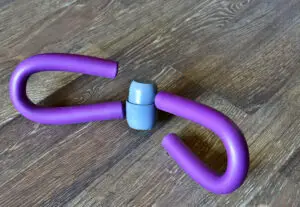Weighted hula hoops have gained popularity in recent years as an enjoyable and effective workout tool. By incorporating a weight into the traditional hula hoop, users experience additional resistance, which helps to strengthen core muscles and burn calories more efficiently.
With various weights and sizes available, purchasing a weighted hula hoop allows individuals to tailor their workout to suit their fitness level and personal preferences.
The benefits of using a weighted hula hoop are numerous and well-documented, even if there is limited research specifically focused on them. Engaging in regular hula hooping sessions can lead to improved core strength, balance, and cardiovascular endurance.
As an aerobic exercise, hula hooping helps to work the heart and lungs, improving oxygen flow throughout the body. This contributes to a reduced risk of heart disease and other health conditions associated with poor cardiovascular fitness.
By using a weighted hula hoop, individuals can make the most of their hula hooping workouts, targeting specific muscles, such as the abdominals and obliques, and enhancing their overall fitness levels. With proper technique and commitment, weighted hula hoops offer an exciting, low-impact alternative to traditional workouts, making exercise more accessible and fun for everyone.
The Science Behind Hula Hooping
Weighted hula hooping is a fun and engaging exercise that combines movement, rhythm, and core strength. As a form of cardiovascular exercise, it is effective for burning calories and supporting heart health.
In addition, regular practice with a weighted hula hoop can lead to improved aerobic health and reduced waist size.
The process of hula hooping requires the user to maintain a rhythmic motion through their hips and core. This constant engagement of the core muscles helps to develop strength and stability in the abdominal and lower back areas.
Weighted hula hoops add an extra challenge to the workout due to their increased size and weight, requiring even more effort from the core muscles.
In addition to the physical benefits, hula hooping also supports brain health. The rhythmic motion and coordination required to keep the hula hoop in motion can help improve cognitive function and concentration.
Moreover, using a weighted hula hoop for exercise can help redistribute body fat and contribute to a healthier waist-to-hip ratio. This is significant as it can play a role in reducing the risk of certain health issues, such as heart disease and diabetes.
With proper form and consistency, incorporating weighted hula hooping into a fitness routine can offer a variety of health benefits. As a low-impact exercise, it is suitable for people of all ages and fitness levels.
Furthermore, the enjoyable nature of the activity may encourage individuals to view it as a fun pastime rather than a chore, increasing the likelihood of maintaining their exercise routine.
Core and Muscular Benefits
Improvement of Core Muscles
Weighted hula hooping offers an effective way to engage and strengthen core muscles. As the user moves their hips to keep the hoop spinning, it requires activation of the abdominal muscles and trunk muscle mass.
This in turn contributes to an improved overall core strength and stability, making everyday activities easier and reducing the chances of injury1.
Enhancement of Lower Back Strength
In addition to targeting the abdominal muscles, weighted hula hooping also benefits the lower back muscles.
Continuous and rhythmic movements needed to sustain hooping place a gentle demand on these muscles, promoting strength and endurance in the lower back region.
Over time, this can lead to better posture and a decreased likelihood of developing lower back pain.
Engagement of Obliques
Weighted hula hooping not only strengthens the core and lower back but also engages the oblique muscles. These muscles are located on the sides of the abdominals and play a crucial role in providing stability and supporting trunk rotation.
Hula hooping challenges the obliques through the circular motion and side-to-side movements required to maintain the hoop momentum.
Moreover, the added weight of the hoop enhances the intensity of the workout, further promoting oblique muscle activation and development.
In summary, weighted hula hooping benefits core and muscular development through stimulating core muscles, enhancing lower back strength, and engaging the obliques. This enjoyable activity offers a fun yet effective way to improve overall core strength, stability, and posture, while reducing the risk of injury.
Weighted Hula Hoops and Calorie Burn
Weighted hula hoops provide an effective and enjoyable workout, which is particularly useful for individuals looking to burn calories and lose weight.
Engaging in regular exercise with a weighted hula hoop can offer numerous health benefits, including strengthening the core muscles and improving overall fitness.
A study conducted by the American Council on Exercise found that a 30-minute hula hooping workout burns an average 210 calories, making it a comparable calorie-burning exercise to bootcamp-style classes, kickboxing, and step aerobics. Considering the fun and engaging nature of hula hooping, this calorie burn is particularly impressive.
The Mayo Clinic states that women may burn about 165 calories during a 30-minute hula hooping session, while men can burn around 200 calories. Such calorie burn rates are similar to other aerobic activities, further illustrating the effectiveness of weighted hula hoops in achieving fitness goals.
Perhaps a lesser-known benefit of weighted hula hoop workouts is the impact on waist and hip measurements. Hula hooping provides a level of exercise comparable to the NHS-recommended 150 minutes of moderate exercise or 75 minutes of vigorous activity per week, potentially leading to a trimmer waist and hips when combined with a balanced diet.
In conclusion, incorporating weighted hula hoop workouts into your exercise routine can offer an enjoyable and effective way to burn calories, trim your waist and hips, and improve overall fitness.
The clear calorie-burning benefits combined with the fun factor make weighted hula hoops a popular choice for both seasoned exercisers and beginners alike.
Cardiovascular Benefits
Weighted hula hoops offer an enjoyable and effective way to enhance cardiovascular health. Engaging with this fun activity on a regular basis helps to boost one’s heart rate and aerobic fitness.
Using a weighted hula hoop is an excellent form of aerobic exercise. Aerobic exercises work the heart and lungs, thereby improving the flow of oxygen throughout the body.
Consequently, a person’s cardiovascular fitness is enhanced, leading to a healthier heart, stronger lungs, and increased stamina.
As participants engage in hula hooping, their heart rate increases. This helps to support cardiovascular health by making the heart more efficient in delivering oxygen-rich blood to the body’s muscles and tissues.
In addition to this, regular sessions of hula hooping can improve blood circulation, ultimately contributing to a reduced risk of heart diseases.
Weighted hula hooping also aids in burning calories, adding to the overall benefits to cardiovascular health. It encourages weight management, which plays an important role in maintaining a healthy cardiovascular system.
By incorporating weighted hula hooping into one’s regular exercise regimen, individuals can actively support their heart health in an enjoyable way.
In summary, weighted hula hooping provides numerous cardiovascular benefits, such as improving heart rate, cardiovascular fitness, and aerobic health.
Regularly participating in this engaging activity is an excellent method to enhance overall well-being and support a healthier lifestyle.
Weighted Hula Hoop for Beginners
Choosing the Right Hoop
When first starting with a weighted hula hoop, it is essential to choose the correct hoop that suits your needs and abilities.
As a beginner, you want to opt for a hoop that is appropriate for your body size, fitness level, and your goals.
Generally, a larger and lighter hoop is recommended for beginners, as it will spin slower and make it easier to maintain its rotation.
As you get more comfortable with the weighted hoop, you can gradually increase the hoop weight to provide a more intense workout and challenge your core muscles.
Safety Measures for Beginners
As with any fitness activity, it is crucial to prioritize safety when using a weighted hula hoop. Here are some key safety measures for beginners to follow:
- Warm-up: Before starting your practice, engage in a few minutes of light warm-up exercises to prepare your body and avoid potential injuries.
- Padding: Use a hoop with padding to protect your body from the hard, weighted surface. Some weighted hoops are covered with foam to provide comfort and prevent bruising.
- Proper stance: To avoid strain on your lower back, stand with your feet hip-width apart and maintain a strong core while hooping.
- Build up gradually: Start with shorter durations and lower hoop weights, then gradually increase the time and weight as you grow more comfortable and develop better control.
Starting Practice
To effectively incorporate a weighted hula hoop into your fitness routine, practice regularly and follow specific techniques. Beginners should initially aim for 5-10 minutes of hooping, working up to 20-30 minutes as they progress. Here are some tips to aid in starting your practising sessions:
- Positioning the hoop: Place the hoop against your lower back, holding it parallel to the ground.
- The push-off: Give the hoop a firm push in either direction, ensuring it starts spinning horizontally around your waist.
- Hip movement: To maintain the hoop’s rotation, move your hips in a circular motion or back and forth.
Remember, practice makes perfect. Don’t be discouraged if it doesn’t come naturally at first. With consistency and determination, you’ll see improvements in your hooping skills and enjoy the various benefits of incorporating a weighted hula hoop into your fitness routine.
Weight Loss and Body Sculpting
Weighted hula hoops offer a unique and enjoyable approach to weight loss and body sculpting. Participants can expect to see improvements in their waist size and overall body composition, including reductions in body fat.
Weighted hula hooping primarily targets the abdominal muscles, including the obliques, resulting in a slimmer and more toned waistline.
This calorie-burning exercise also has the added benefit of engaging the whole body, due to the need for stability and balance when manoeuvring the hoop. This ensures that participants not only work on their abs but also other areas such as the legs and arms, paving the way for more effective weight loss.
Consistency is key, and users have experienced positive results when practising with a weighted hoop on a daily basis for at least six weeks.
During this time, it is possible to see a decrease in body fat, as well as improvements in physical fitness and muscle tone. It is essential to maintain a healthy diet and engage in additional forms of exercise to ensure the best results when using a weighted hula hoop for weight loss and body sculpting.
Another advantage of weighted hula hoops is their potential effect on hip circumference.
When used correctly, hooping can lead to a reduction in hip size, as it both strengthens and tones the surrounding muscles. In turn, this can contribute to improved posture and a more aesthetically pleasing physique.
In conclusion, weighted hula hoops provide a fun and engaging form of exercise that can ultimately aid in weight loss, body sculpting, and a host of other benefits.
Participants should remain consistent in their practice and combine hooping with other healthy habits to reach their physical fitness goals.
Potential Drawbacks and Precautions
Weighted hula hoops offer many benefits such as improving cardiovascular health, core strength, and endurance. However, precautions should be taken to avoid potential drawbacks and injuries.
Possible Injuries
Using a weighted hula hoop may not be suitable for everyone, especially individuals with back pain or existing injuries. The repetitive motion can put additional strain on the spine and cause discomfort or exacerbate existing problems.
In some cases, improper technique or overexertion may lead to muscle strains and other injuries. It’s always best to consult a healthcare professional before starting a new exercise routine, especially if you have any pre-existing conditions.
Avoiding Bruising
Some people may experience bruising while using a weighted hula hoop, particularly in the beginning stages of their exercise routine. This is mainly due to the hoop’s weight repeatedly impacting the body.
To minimise the risk of bruising, choose a hoop with a padded or smooth exterior.
In addition, starting with a lighter hoop and gradually increasing the weight can allow your body to adjust over time.
Monitoring for Muscle Soreness
While some muscle soreness can be normal after a new or intense workout, it’s essential to monitor your body’s response to using a weighted hula hoop.
If you experience significant or persistent muscle soreness, it may be an indication that you are either using improper technique, overtraining, or that your body is not yet ready for the exercise.
To prevent excessive muscle soreness, it’s recommended to incorporate weighted hula hooping into your exercise routine gradually. Start with shorter sessions and slowly increase the duration as your body becomes more accustomed to the movement.
Additionally, incorporating stretching exercises before and after the hula hoop workout can help alleviate soreness and improve flexibility.
Remember, the key to benefiting from a weighted hula hoop workout is to practice proper form, listen to your body, and take precautions to avoid potential drawbacks.
Weighted Hula Hoop Exercises
Weighted hula hoops are a versatile fitness tool that can be incorporated into various workout routines. They provide unique benefits like improving balance, strengthening the core, and potentially burning calories. I
n this section, we’ll discuss a few exercises that utilise weighted hula hoops in your fitness routine.
Before starting any weighted hula hoop workout, it is essential to perform a proper warm-up. This can involve dynamic stretches and light aerobic exercises to increase heart rate and prepare the body for more intense movements.
Once warmed up, make sure to use proper form and technique when handling the weighted hula hoop.
A basic but effective workout using a weighted hula hoop is simply swinging it around your waist in a circular motion.
- Stand with your feet shoulder-width apart, hold the hoop at waist level, and initiate the movement by giving it a slight push in either direction.
- As the hoop gains momentum, engage your core muscles and maintain a rhythmic motion for the desired duration.
- This exercise can be performed for a set amount of time or in intervals to increase the intensity.
Lunges are another great way to incorporate weighted hula hoops into your exercise routine.
- While holding the hula hoop overhead, take a step forward with one foot and lower into a lunge position.
- Keep the front knee aligned with the ankle and ensure the back knee hovers just above the ground.
- Hold this position for a moment before returning to the starting position.
- Alternate legs and perform the desired number of repetitions.
The added weight of the hula hoop will challenge your balance and engage your core muscles during the movement.
Squats can also be performed with a weighted hula hoop.
- Hold the hoop at chest level with both hands and stand with your feet shoulder-width apart.
- Lower yourself into a squat position, keeping your chest lifted, and maintain the hoop in front of your body throughout the movement.
This variation of squats adds resistance and targets your upper body as well as your lower body.
Incorporating planks into your workout routine can help strengthen your core, and adding a weighted hula hoop adds an element of instability.
- Begin in a traditional plank position with your hands shoulder-width apart and the hula hoop positioned around your lower legs.
- As you maintain the plank position, carefully move the hoop around your legs in a circular motion to engage your core muscles further.
Utilising weighted hula hoops in your fitness routine offers a fun and engaging approach to exercise while targeting various muscle groups. These exercises can be easily incorporated into your existing workout plan, providing a refreshing way to challenge your body and improve your overall fitness.
Top Tips for Using Weighted Hula Hoops
Using a weighted hula hoop is an enjoyable way to improve your fitness, burn calories, and strengthen your core muscles. To make the most out of your hula hooping sessions and avoid injuries, follow these expert tips below.
Firstly, it’s crucial to choose the right size and weight of the hula hoop. As a general rule, the hoop should reach somewhere between your waist and chest when it’s resting vertically on the ground. For beginners, it’s recommended to start with a hoop weighing around 1 to 2.5 pounds. You can gradually increase the weight as you become more comfortable and experienced.
Consulting a personal trainer or attending a hula hoop class can help you learn proper form and technique, ensuring that you get the most out of your workouts. Personal trainers can also provide advice on how to progress your sessions, as well as give recommendations for specific exercises and routines tailored to your fitness goals.
Developing your coordination is crucial when using a weighted hula hoop. Start by hooping in both clockwise and counterclockwise directions, as this will help you develop better control and balance. Additionally, try practising with the hoop around different parts of your body, such as your arms or legs, to enhance your overall coordination.
Maintaining proper form is essential when using a weighted hula hoop, as it can prevent injuries and ensure effective workouts. Keep your feet shoulder-width apart, engage your core, and slightly bend your knees while hooping. It’s also important to avoid twisting your back; focus on keeping your upper body stable and rotating your hips instead.
Remember to monitor your progress and adjust your workouts accordingly. Set realistic goals and take note of improvements in your fitness and physical abilities. Having a clear understanding of your progress will keep you motivated and help you determine when it’s time to increase the intensity or duration of your hula hooping sessions.
Incorporating rest days into your routine is essential, as it allows your muscles to recover and helps prevent overuse injuries. Hula hooping may be a low-impact activity, but it’s still important to give your body time to rest and repair itself for optimal performance.
By following these tips, you’ll be well on your way to reaping the numerous benefits of weighted hula hooping, all while having fun and improving your fitness.
Smart Weighted Hula Hoops
Weighted hula hoops have been gaining popularity in recent years as an effective and enjoyable way to achieve fitness goals. The introduction of smart weighted hula hoops has taken this fitness trend a step further.
Now, these modern hoops are creating a buzz on social media platforms like TikTok, and users are experiencing noticeable benefits from their use.
A smart weighted hula hoop differs from a traditional weighted hoop, as it is designed to provide a more targeted workout while being more user-friendly. The added smart features track users’ workout progress and help them set and achieve fitness goals.
Unlike traditional hoops that require constant engagement from the user, a smart hoop allows for a more hands-free experience and enables users to multitask during their workout.
The smart hoop is designed to help tighten the mid-section using centrifugal force and the added weight of the hoop. This additional resistance compared to a regular hula hoop delivers faster and more effective results in weight loss, core strength, and overall fitness.
Along with its adjustable weight, the smart hoop’s modular design allows users to customise its size, providing a tailored fitness experience.
These versatile hoops cater to a wide range of fitness levels, from beginners to seasoned hula hoopers. Their unique design makes them an accessible option for those new to hooping or those who may have struggled with traditional hoops in the past.
In conclusion, smart weighted hula hoops have proven to be an innovative and effective fitness tool. With their dynamic design and engaging digital features, they offer a convenient and enjoyable alternative to traditional fitness regimes.
Final Takeaway
Weighted hula hoops offer an affordable and enjoyable way to engage in a fun workout that can yield significant fitness benefits. Incorporating this type of physical activity into your routine allows you to add variety while working on your core strength, balance, and cardiovascular endurance.
One of the primary advantages of using a weighted hula hoop is its ability to provide a full-body workout while targeting the abdominal muscles and obliques. This makes it a perfect addition to any fitness routine or even group fitness classes, where participants can experience a different, entertaining way to exercise.
In addition to being a cost-effective option, weighted hula hoops are also suitable for users of varying fitness levels. Beginners can easily pick up the technique, while more advanced users can increase the difficulty by adding more weight to the hoop or incorporating additional movements and exercises.
Regular use of a weighted hula hoop may lead to noticeable improvements in waist size and overall body composition, as suggested by a 2015 study where participants experienced a decrease in fat around their waist and hips after six weeks of daily hooping.
In summary, a weighted hula hoop presents a unique and enjoyable way to enhance your fitness routine, making it an ideal option for those seeking an alternative and convenient form of physical activity.

I’m Jennifer a beauty and wellness expert. I believe in promoting a sustainable and healthy lifestyle from within. Helping people feel good is my passion; whether it’s teaching yoga or offering skincare advice.







